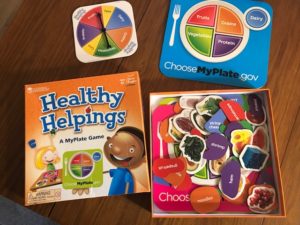The nutrition education is very important for kids from their early ages.
At school, kids learn so many subjects such as Math, Science, Social Studies, Music, English… Some have exams, too.
There is no special school only about nutrition for kids, but every day they receive a nutrition education from their parent(s), family, or at school at the unconscious level but it becomes their habit and it influences their lifetime health.
You don’t have to make your kid(s) sit down at the desk and talk about nutritional science. Please, don’t do it. It’s boring and kids will hate eating healthy.
But you can do some fun activities such as cooking, grocery shopping together, or do some “gamificational” nutrition educations with your kid(s).
Here are some good examples of activities and “gamificational” nutrition educations.
1.Enjoy different kinds of vegetables. Make an original calendar to help your kid(s) put a sticker or draw a smiley face in a box each time a different kind of vegetable is eaten. Kids love putting stickers for a prize and they will enjoy eating vegetables.
2. Go to a farmer’s market monthly and find seasonal vegetables and fruits there. Take photos, and make a family calendar with a simple recipe.
 3. Cook together. Little kids can even help moms to cook. They can’t use knives yet, but they can peel onions, boiled eggs, scale ingredients, wash vegetables and so on. My daughter started helping me cook when she was two years old. They mess up the kitchen, but don’t be mad. They have fun and when kids have fun, they learn a lot. And they will learn how to clean the kitchen with the passage of time.
3. Cook together. Little kids can even help moms to cook. They can’t use knives yet, but they can peel onions, boiled eggs, scale ingredients, wash vegetables and so on. My daughter started helping me cook when she was two years old. They mess up the kitchen, but don’t be mad. They have fun and when kids have fun, they learn a lot. And they will learn how to clean the kitchen with the passage of time.
4. Use a MyPlate Game. I found this game at Amazon, it is a very educational game for kids to teach them to identify foods and their food groups according to the USDA-approved MyPlate, and create healthy meals as part of game play. Kids spin the spinner with food groups and select a food from food cards and place it to their own placement (MyPlate), then the first player to complete a healthy meal on the plate wins. My daughter loves that game.
I found this game at Amazon, it is a very educational game for kids to teach them to identify foods and their food groups according to the USDA-approved MyPlate, and create healthy meals as part of game play. Kids spin the spinner with food groups and select a food from food cards and place it to their own placement (MyPlate), then the first player to complete a healthy meal on the plate wins. My daughter loves that game.
5. Make three same-sized vegetable pies with your kid(s) and explain Pi (π) using the Pies. If you want to teach your kid(s) math at the same time, this will be fun. Your kid(s) might not know what is Pi, but you know Pi as 3.14 basically. You might remember the equation (Pi=Circumference/Diameter), but you might forget where does the number come from. Every kid who learned fractions can easily understand about the equation of Pi. So don’t wait until they learn it at school.
After you make the pies (they should be the same size), place those pies next to each other without any spaces.
Then using a piece of paper, make a circle the same size as the pie. And make 16 diameter lines to make 32 equal parts. Cut it in half, then make a incision in each radius, but do not separate the parts. When you are done, place the circumference line on the diameter of each pie from one end to the other. And you will find that the circumference is slightly longer than the total length of the three pies’ diameters.
 |
 |
 |
 |
 |
 |
Cut a pie in half, explain to your kid(s) that it’s called diameter (an end to end line that pass through the middle of a circle), and the crust is the circumference (the distance around a circle). One circumference is equal to about 3.14 diameters.
How is that? Have fun!
























コメントを残す